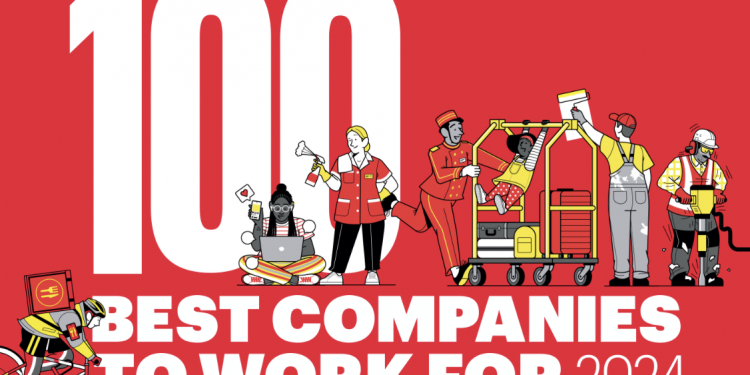Levi Strauss’s CHRO Details Why the Company Expanded Family Leave

This interview was created in collaboration with the Financial Health Network.
Over the last few years, expectations of how employers treat their workers has undergone noticeable shifts. Employees from across sectors increasingly expect more holistic support from their employer. High-performing employers are taking note, recognizing that a holistic benefits strategy – one that focuses on the whole employee – results in a more stable, financially healthy workforce.
Part of a holistic benefits strategy includes recognizing individual workers as members of families and communities. Access to paid leave is estimated to increase mothers’ labor force participation by approximately 20 percent during the first year following their child’s birth. Furthermore, having access to paid medical leave has led workers to experience less stress from financial insecurity during a health shock. Recently, Levi Strauss & Co. (LS&Co) expanded its paid family leave plan to be more inclusive of its global workforce. Using data and feedback from employees, HR leaders designed a paid leave benefit that provided support to a wide range of employees.
In this interview produced by JUST Capital and Financial Health Network (two of the partners in the Worker Financial Wellness Initiative) we talk with Tracy Layney, Levi Strauss & Co.’s Chief Human Resources Officer, discussing the company’s decision to continue expanding their paid family leave plan.
What prompted you to expand your parental leave plan to a paid family leave plan?
One of the most important ways that LS&Co. stands up for our values is by standing up for our most important audience: our employees. We see it as our responsibility to create an environment that enables employees to be healthy, happy, and successful at work and at home.
We’ve seen the positive impact of paid leave in our employees’ lives since we introduced paid parental leave in 2016. Access to paid family and medical leave is not only the right thing to do for employees, but it’s the smart thing to do for business. So, in 2020 we expanded the benefit to include paid family leave. Then, at the beginning of this year, we enhanced the standard of our paid leave benefit around the globe to ensure our eligible employees have equitable access to time off work for maternity leave, parental bonding leave, and family care leave.
How did you build the case internally for a family leave plan and then decide to expand it globally? How was data incorporated into this process?
We had heard strong feedback on the need for paid family leave from our workforce. From a U.S. home office perspective, more than 50% of our population is made up of individuals between the ages of 36 and 55 – part of the so-called “sandwich generation” that is more likely to be caring for both a child and an elder at the same time. We realized that to truly support employee well-being, we must support employees’ ability to care for their closest family members, whether that person is a child, spouse, parent, or domestic partner, without worrying about their job or their paycheck.
Over the past few years, we’ve implemented and advocated for paid family leave and paid sick leave for our employees in certain locations and have seen firsthand the impact this has had on our employees’ lives. Our people make us who we are, and it’s our responsibility to create an environment that enables them to be healthy, happy, and successful, both at work and at home.
We wanted to ensure eligible employees receive the same paid leave benefit regardless of their geographic location, so we created a global core minimum standard. This allows us to provide eligible employees with up to:
- 12 weeks of paid pregnancy (maternity) leave with enhanced flexibility on timing.
- 8 weeks of paid parental bonding leave, available to both parents (primary and secondary).
- 8 weeks of paid family care leave to care for immediate family members, including domestic partners.
Our goal with the enhancement was to create an equitable global core minimum standard, thus providing a stronger safety net for our employees wherever they are located. Our previous policy minimums were contingent on local laws and standards around the world — employees were in theory eligible for a variety of paid leave benefits depending on their region, but it didn’t always work out that way in practice. By raising the minimum standard across the board, many LS&Co. eligible employees will and are currently experiencing an enhancement in this benefit.
What advice would you give organizations and HR leaders that want to take a data-centric approach to benefits equity?
Our driving force and our motivation is our employees. At LS&Co., our people make us who we are and it’s our responsibility to create an environment that enables them to be healthy, happy, and successful at work and at home. Companies play a role in being the employer their employee needs in today’s landscape. This includes ensuring their people don’t have to choose between their careers and their health.
Companies should expand access to paid leave because this issue directly affects them, their workforces, and their ability to stay competitive in our modern U.S. economy. I would encourage everyone to foster conversations with their companies and dig deeper into the business rationale behind it.
Paid family leave is a relatively small investment with a very meaningful return, our actual expense is tracking under initial projected expense. Our paid family care policy globally costs us only 36% of what we’d projected, and since our global enhancement in January, we’ve had over 260 leaves across 20 countries.
Interested in more content like this?
Sign up for The JUST Report, our weekly newsletter that delivers curated, cutting-edge insights to help you stay informed, stay inspired, and stay steps ahead of the competition when it comes to delivering value to all your stakeholders.
Sign Up Here.
How have your expansive family leave policies impacted your workforce?
During COVID, our company saw much lower attrition and impact on women than the average numbers across the U.S. and we believe it is because of our benefits and company culture (It is an expense to rehire and train people – paid leave boosts retention.) We realized that to truly support employee well-being, we must support employees’ ability to care for their closest family members, whether that person is a child, spouse, parent, or domestic partner, without worrying about their job or their paycheck.
Also, showing employees we have their backs cultivates loyalty, supports productivity, and fosters a culture where people do their best work. Comprehensive family and medical leave policies also help further equality and diversity goals, allowing more people to take advantage of professional opportunities that present themselves.
Do you plan to expand your current policies, or are there areas of interest you’re pursuing regarding care benefits? How has data influenced these decisions?
At Levi Strauss & Co., we are committed to offering a wide array of benefits and support for our employees in ways that are both tailored to their unique needs and can help them look after themselves and their loved ones, and one of those ways is through our ongoing mental health and well-being offerings. Most recently, we expanded access to Lyra Health’s emotional well-being support, available to all our employees around the world and their household family members.
Ongoing mental health resources are ingrained in the day-to-day culture and benefits of LS&Co. These include providing accessible, always-on resources that help our people prioritize mental and physical health and manage symptoms of stress, anxiety, and depression, should they arise. We train our managers to lead from the heart and with understanding. There is no one-size-fits-all leadership style, but by making small changes in the way we communicate with our people, we can foster a culture rooted in authenticity and empathy.






